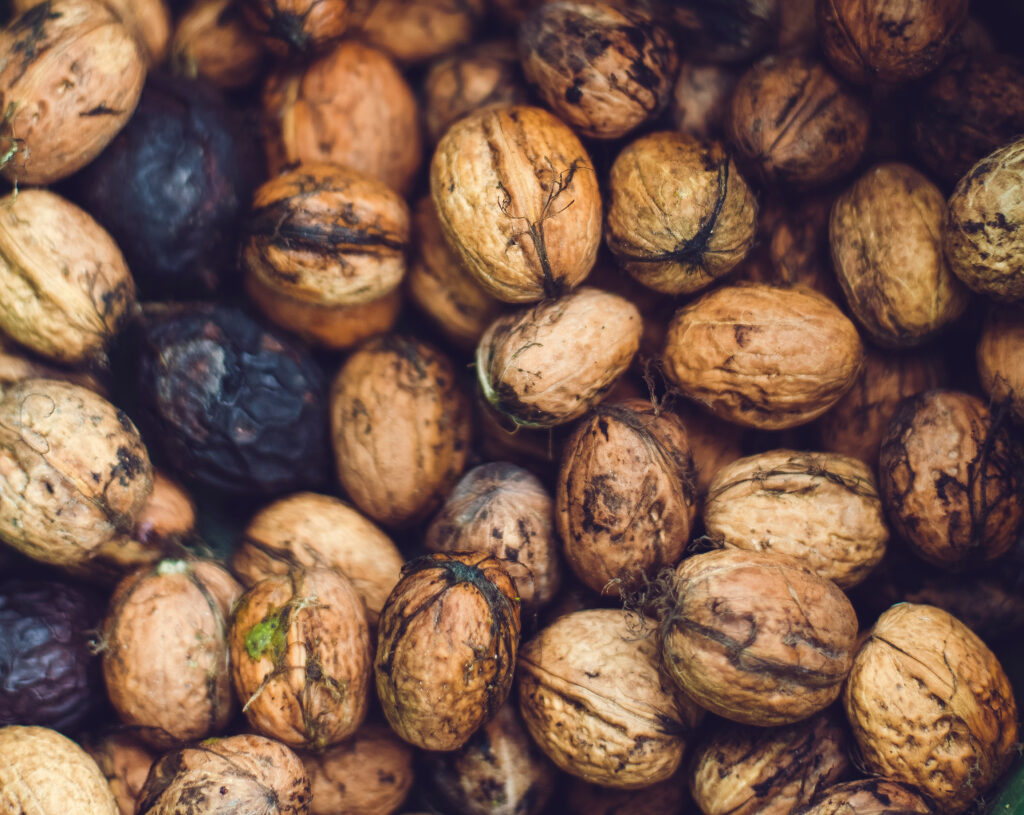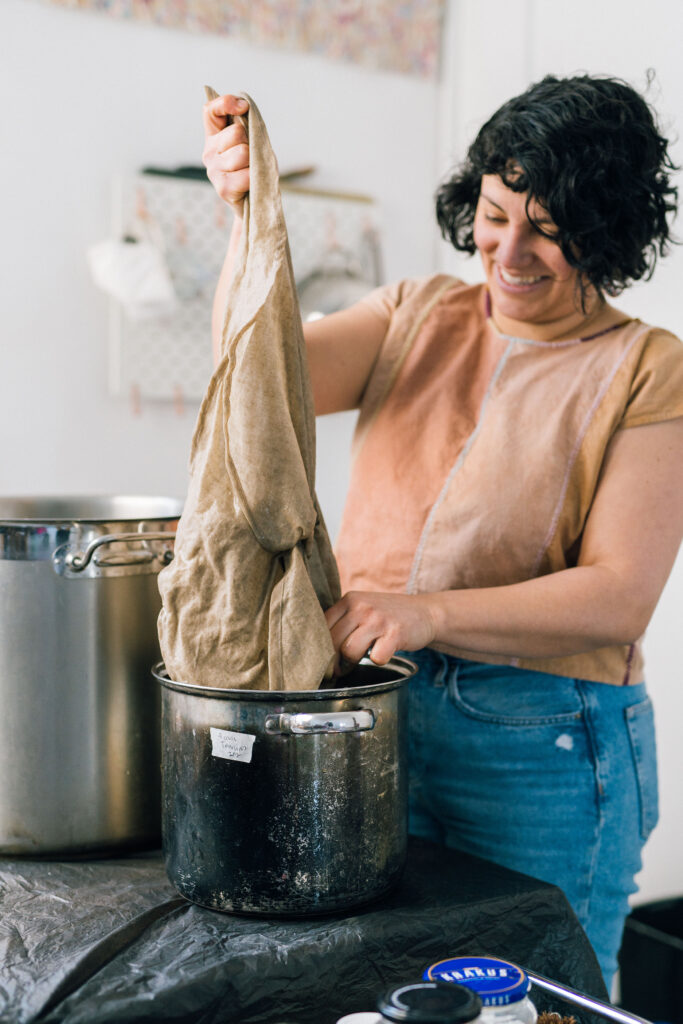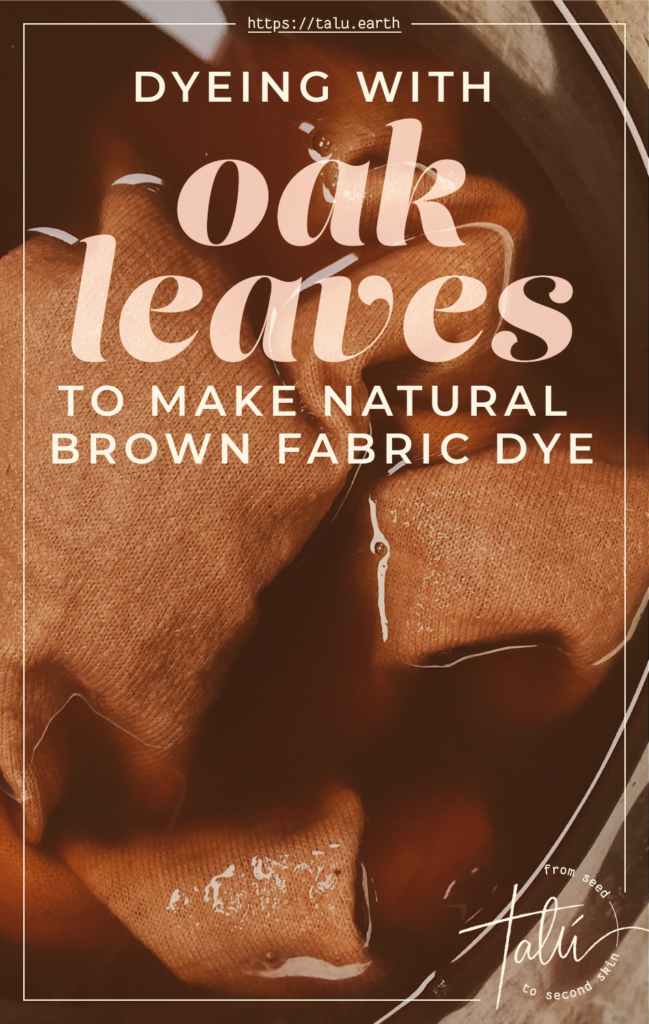Imagine the endless creativity that can be found beneath the fallen leaves of Autumn.
There’s nothing quite like the earthy, comforting feeling of Autumn… walking through crisp, brown leaves and feeling the raw beauty of the seasonal change.
Another thing I love about this beautiful time of year is the many different shades of brown.
From cinnamon and tan to deeper shades of hickory and chocolate, incorporating brown into an outfit always has a way of making us feel fresh, stylish and contemporary.
Feeling confident at dyeing your own clothes and mastering the perfect natural brown fabric dye makes Autumn even more interesting!
Let’s explore all there is to know about dyeing with oak leaves to create natural brown fabric dye and how you can naturally dye your own fabrics and textiles in your favourite shades of brown.

What are the best sources for creating natural brown fabric dye?
Oak leaves
Of all the options we have to choose from, the traditional Oak leaf provides very effective results.
Rich in Irish history and with an abundance of resources all over the world, the Oak leaf can produce a vast array of shades that always leads to long-lasting colour due to its high levels of tannin.
And the magnificence of this leaf doesn’t end there – the bark, twigs and acorns can also be used to create a rich and solid shade of creamy brown.

Walnut husks
Using walnut husks is another fun way of getting a good selection of brown shades using natural brown fabric dye.
Walnut dye doesn’t actually require any mordanting and is a super simple process in general, however keep in mind that the colour you end up with will very much depend on the amount of time you leave the dyestuff soaking. You can expect to get rich, chocolatey hues from this potent dyestuff.
Alder cones
Dyeing fabric with alder cones is a unique dyeing option for our friends across the pond in North America, Canada and in some parts of Europe too, including Ireland and the UK.
Whether these cones are beneath white snow in the Winter or sat high up in a tree in the warmer months, Alder cones can create a plethora of warm brown-golden shades like honey and caramel.

Eucalyptus bark
It really is incredible just how many uses we have for eucalyptus! The bark of this tree is used not only to dye fabrics naturally, but has also been used for centuries to tan leather in all different products.
Natural fibres pair beautifully with natural brown fabric dye.
Natural fabrics are the most practical options for any natural dyeing process.
The majority of the most well-known natural materials can be dyed and will almost always produce an effective result. The best options are cotton, linen hemp, wool and silk.
The step by step of dyeing with oak leaves to create natural brown dye:
For best results that stand the test of time, be sure to scour and mordant your textiles before dyeing. You can learn these processes step by step in my signature course Living Colour with the Five Elements to tap into each step in depth.
For an immersion in the process of dyeing with oak leaves, you will need to extract the colour from the leaves and then dye your textiles with it.
You will need:
- Fibres you’ll dye
- Kitchen scales
- A dedicated dye pot
- A dedicated wooden spoon, tongs or a stick
- Sieve
- Heat source
- Dyestuff (in this case, oak leaves!)
Extraction process for dyeing with oak leaves:
- Weigh your leaves. Use at least 150% of the weight of the fibre of oak leaves. So, if you’re dyeing 100g of fibre, use at least 150g of oak leaves.
- Place your leaves in a pot and add enough water to cover them. For best colour results, leave them soaking at least for one night before simmering.
- The longer you soak before extracting, the more intense colours you’ll get. After having left to soak for at least one night, simmer for an hour and, again, preferably leave to steep overnight before dyeing.
- Strain your dye material, keeping only the liquid. Throw the spent leaves in your compost bin.
How to make natural brown fabric dye using oak leaves, step by step:
1. Soak your fibres.
Soak your fibres for at least half an hour before dyeing.
2. Add your wet fibres to the dye pot.
Add more water if needed so that they are completely covered and can move freely.
3. Simmer and stir.
Bring the pot to a low simmer and stir constantly, so that the dye is absorbed evenly.

4. After one hour, turn off the heat and leave to steep.
Once an hour has passed since the water reached a low simmering point, turn off the heat and let the fibres cool down in the pot. If possible, leave them to steep overnight with the lid on.
5. Rinse and leave to dry.
Rinse your fibres under running water until the water runs clear and leave to dry away from direct sunlight.
6. Disposal.
You can dispose of your dye bath directly onto the soil or down the drain.

Ready to create your own masterpiece and learn more about natural dyeing techniques?
Natural textile and fabric dyeing of all types is a one–of-a-kind experience.
Not only does it bring us to the forefront of important education that helps us make better personal choices, but it means that we can each play our part in changing the way society uses and reuses clothing.
The more we can come back to the Land and teach future generations to do the same, we can start to build a more sustainable, natural future that supports everyone in society (and not just some).
If you’d like to learn how to be more ethically conscious with your clothing, but you’re not sure where to start, my signature workshop might just be the perfect first step for you!
Living Colour with the Five Elements shows you exactly how to create a sustainable cycle between Land and Nature so that you can have fun with your wardrobe and have full control over your colour and upcycling options at home.
Pin this post!
